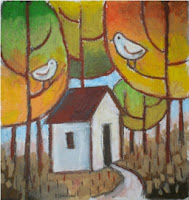 |
| house in the forest , by usartdude |
Have you ever thought how your table or chair looked before you bought it? What was your cabinet doors or your house in their previous life? Imagine yourself standing in the middle of a forest. The sun is partly coming through the bushy treetops playing in the grass. There are pines all around you. On the left from you, there is a dark wood of spruce over a small meadow. You have seen some larches entering the forest. When you start to look around more carefully, you notice also some oke, ash and elm. That is what you should feel around, standing inside a house which is built using natural materials. Let’s find out today which are the most popular trees used in the building sector in Europe. There are only some of them and the popularity of the tree depends on several quality aspects such as hardness, wear durability, cracking resistance, decay and moisture, ability to contain metallic, amount of branches on one meter, ease of the wood and of course the price.
The first place probably should be divided between two trees, but I would like to give it to pine. This tree has a lot of positive properties, it is usually tall and straight and that makes it comfortable for processing. The structure is strong and substantially resistant to decay, because of resin channels. As you can see in the nature, three branches are usually close to the top, so the quantity of branches on metre is close to ideal. Besides it is a quite popular tree in forests and that makes the price competitive. There are other types of trees with better characteristics, but despite quality relation with price, makes pine number one. Usually this wood is used for log houses.
The second place is spruce. The characteristics of spruce are close to those of pine, but the difference is that there are more branches on meter. If it is dry, the structure is strong, however because of less resin channels, it is more vulnerable to decay. Nowadays, there are plenty of variants how to improve the sensibility to decay, and it becomes not so important anymore. After such improvement it becomes even higher level as pine. Of course, any extra treatment rises the price up. Usually spruce is used in frame constructions and for design elements outside the house.
The third place goes to larch. This tree has a high quality indicators – much higher strength than pine and spruce. Better decay resistance, but the price which is exactly the same points, higher as the quality, move this perfect material to the third place. There are houses, made from larch, which are standing more than 300 years. Nowadays usually used for basic, fundamental constructions. The outside wood elements from larch is a smart decision, the only thing is that you need to consider the price.
Next comes white spruce. The structure is close to pine and spruce, but, because of the low resistance to decay, it is mostly used producing windows, doors, floors and another interior details that do not have huge grate outside condition influence.
Cedar is the following. The characteristics of this tree is close to pine, but the difference is that it has antiseptic characteristics, what makes it quite popular in really ecological constructions. Of course, availability and respective price is moving this tree to the end of the coniferous tree top. Cedar is used also in furniture production.
The king of trees- oak. There are a lot of stories concentrated around this majestic tree, because of it fantastic - possible maximum age. Several hundred years is a normal age for an oak, as well as 1000 years is also not exception. The structure is strong and sensibility to different impact is perfect. Before it was used not only in constructions, but also in shipbuilding. Today it is usually used to produce furniture, doors, parquet or different kinds of exclusive inside design elements.
Ash closes our top. It has lower quality than oak. It is more sensible to decay and the structure is much weaker, but exactly because of availability and price, it is more popular than oak. You can see ash in lots of inside interior details.
Each tree has several varieties, but if we will start to explore all of them, we will have a blog about trees not building, so next time we will find out where forests which supply Europe building sector with materials, are situated.







